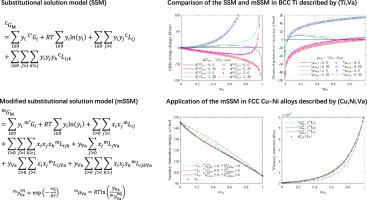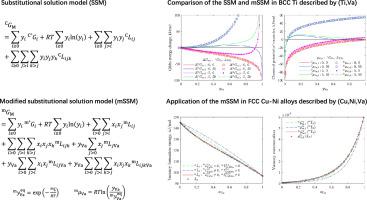A modified substitutional solution model for describing thermal vacancies
IF 9.3
1区 材料科学
Q1 MATERIALS SCIENCE, MULTIDISCIPLINARY
引用次数: 0
Abstract
Thermal vacancies are critical structural defects in metals, significantly influencing various material properties, such as diffusivity and thermal conductivity. The Compound Energy Formalism (CEF) has been extensively utilized to describe phases with sublattices. However, researchers have yet to reach a consensus on determining the molar Gibbs energies of vacancies, even when employing the substitutional solution model (SSM) as a single-sublattice CEF model. This is due to challenges in assigning physically meaningful values to the molar Gibbs energy of vacancies without encountering issues such as multiple equilibrium vacancy concentrations and phase stability. In this study, we propose a modified SSM (mSSM) to provide a physically consistent description of vacancies. A comprehensive comparison between the SSM and mSSM is presented. The mSSM allows the molar Gibbs energy of vacancies to be assigned physically meaningful values and enables the derivation of a unique analytical solution for the equilibrium vacancy concentration. It is applied to the FCC phase of the Cu-Ni system to accurately predict vacancy formation energies. Notably, parameters previously determined using the SSM can be directly applied in the mSSM, yielding close results at equilibrium. When vacancies are excluded, the mSSM reduces to the SSM. However, it is advisable to reoptimize parameters related to vacancies in the mSSM, such as the positive molar Gibbs energy of vacancies, to obtain physically meaningful results.


描述热空位的改进替代溶液模型
热空位是金属中重要的结构缺陷,对材料的各种性能,如扩散率和导热性有重要影响。复合能量形式(CEF)已被广泛用于描述具有子晶格的相。然而,即使采用取代溶液模型(SSM)作为单亚晶格CEF模型,研究人员在确定空位的摩尔吉布斯能方面仍未达成共识。这是由于在不遇到多重平衡空位浓度和相稳定性等问题的情况下,为空位的摩尔吉布斯能分配物理上有意义的值所面临的挑战。在这项研究中,我们提出了一个改进的SSM (mSSM)来提供一个物理上一致的空缺描述。对SSM和mSSM进行了全面的比较。mSSM允许空位的摩尔吉布斯能被赋予物理上有意义的值,并且能够推导出平衡空位浓度的唯一解析解。将其应用于Cu-Ni体系的FCC相,可以准确地预测空位形成能。值得注意的是,先前使用SSM确定的参数可以直接应用于mSSM,在平衡状态下产生接近的结果。当排除空缺时,mSSM减少为SSM。然而,为了获得有物理意义的结果,建议重新优化与mSSM中空位相关的参数,如空位的正摩尔吉布斯能。
本文章由计算机程序翻译,如有差异,请以英文原文为准。
求助全文
约1分钟内获得全文
求助全文
来源期刊

Acta Materialia
工程技术-材料科学:综合
CiteScore
16.10
自引率
8.50%
发文量
801
审稿时长
53 days
期刊介绍:
Acta Materialia serves as a platform for publishing full-length, original papers and commissioned overviews that contribute to a profound understanding of the correlation between the processing, structure, and properties of inorganic materials. The journal seeks papers with high impact potential or those that significantly propel the field forward. The scope includes the atomic and molecular arrangements, chemical and electronic structures, and microstructure of materials, focusing on their mechanical or functional behavior across all length scales, including nanostructures.
 求助内容:
求助内容: 应助结果提醒方式:
应助结果提醒方式:


